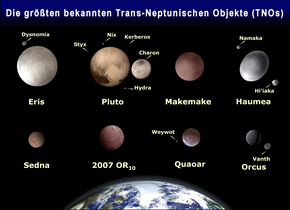Plutoid
A plutoid is a trans-Neptunian dwarf planet .
definition
According to the decision of the International Astronomical Union (IAU) on June 11, 2008, Plutoids are a subclass of the dwarf planets. So they must have an orbit around the sun and have enough mass to take on a hydrostatic equilibrium form (approximately spherical shape) through their own gravity . However, they must not have cleared their orbit of other objects, as is the case with planets taking into account the planetary discriminant , and they must not be a satellite . In contrast to the other dwarf planets, an additional criterion for the Plutoids is that the major semi-axis of their orbit around the sun must exceed that of Neptune .
This means that the dwarf planet Ceres is not called a plutoid, as it is located in the asteroid belt between Mars and Jupiter and therefore does not orbit the sun beyond the orbit of Neptune.
The dwarf planets that received Plutoid status at the time of definition were named after Pluto and the somewhat smaller Eris . It can be assumed, however, that further plutoids will be discovered in the area behind Neptune's orbit, and the already known approximately spherical trans-Neptunian objects of the solar system are also referred to as plutoids after their classification as dwarf planets.
Naming process
In a naming process led by the International Astronomical Union's Committee on Small Body Nomenclature (CSBN) and the IAU Working Group for Planetary System Nomenclature (WGPSN), all celestial bodies of the solar system are to be considered as plutoids for naming purposes, whose major semi-axes are larger than the of Neptune and whose absolute brightness is brighter than +1 mag. The classification as a dwarf planet or downgrading to a planetoid is verified in the context of further observations. As a result, Makemake and Haumea were also assigned to the Plutoid category.




